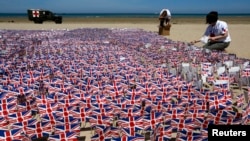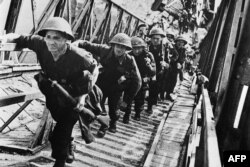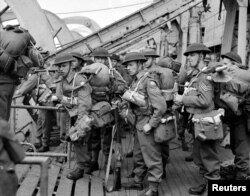He never came home — another citizen-soldier whose destiny was to be a fading black and white photograph on a widow’s mantelpiece.
“My thoughts at this moment, in this lovely Saturday afternoon, are with you all now,” wrote Capt. Norman Skinner, a Londoner and 38-year-old former insurance salesman. “I can imagine you in the garden having tea with Janey and Anne getting ready to put them to bed.”
His letter to wife Gladys — which he carried in his pocket as he stormed ashore on the French coast in the D-Day landings 75 years ago — will be read from by British Prime Minister Theresa May Wednesday at a ceremony in Portsmouth, marking the anniversary of the largest seaborne invasion in history, the opening chapter in the even bloodier battle for Normandy, code-named Operation Overlord.
The prime minister’s audience will include U.S. President Donald Trump and other world leaders, coming together to honor those who fought and died. Among them, 2,000 Americans from the U.S. 1st and 29th Divisions at Omaha Beach, where the most savage fighting of all of the five beaches of D-Day took place and where the fate of the landings hung in the balance for several hours.
“Although I would give anything to be back with you, I have not yet had any wish at all to back down from the job we have to do,” Skinner wrote to his wife, on the eve of his landing at Sword Beach amid the earth-shaking thunder of a naval bombardment, the crossfire of rattling German machine guns, mortar and artillery.
He was killed in a foxhole that took a direct hit.
In some ways Skinner was more quietly confident than many of his superiors.
Britain’s top army commander, Gen. Alan Brooke, wrote the night before D-Day: “I am very uneasy about the whole operation.” He feared at best it wouldn’t meet expectations and in the worst case scenario end up being “the most ghastly disaster of the whole war.”
The Normandy landings weren’t the first Allied seaborne invasions of mainland Europe during World War II. That honor goes to the Salerno landings nine months earlier, a bungled operation according to many historians, which necessitated a subsequent landing in January 1944 further north on the Italian coast at Anzio.
In the run-up to D-Day, Allied forces were having a difficult time in Italy and were bogged down by a skillful rear guard action overseen by Gen. Albert Kesselring. He was Germany’s top commander in Italy, a veteran and considered one of Hitler’s wiliest tacticians.
U.S. commanders in Washington had been against an Italian landing, which the dogged Winston Churchill pushed. They feared it would be a distraction from the main event, and Salerno only happened because of the intervention of U.S. President Franklin Roosevelt, who thought he had to agree with Britain’s war leader for the sake of the Anglo-American alliance.
For more than a year, the British had resisted American (and Russian) demands for a landing at Normandy, or somewhere in northwest Europe. Churchill’s favored strategy was for delay. He believed that Nazi Germany would slowly disintegrate thanks to Allied air raids on German industrial centers and cities. German military strength would be exhausted fighting the Russians in the east and the Western Allies in Italy. Better to wait, then, was his thinking.
“I have always believed that, but for American insistence, D-Day would have happened only in 1945, not 1944,” British military historian Max Hastings wrote recently.
The British were not confident of success, fearing there were too many imponderables, including how effectively Germany’s military would respond. Military strategists estimated that the Germans could reinforce their troops in Normandy much more quickly than the Allies. One calculation was that within 14 days after the landings, the Germans could outnumber Allied forces by 28 divisions to 19.
Hence the intensive Allied bombing of roads and railways in northern France ahead of D-Day — an effort to reduce German maneuverability.
Ironically, assistance came from a strange source. Adolf Hitler refused to budge German forces from further north around Calais, believing that the Normandy landings were a feint, a belief he held fast to, due to brilliant deception tactics and the trailing of false leads by British intelligence.
The D-Day landings went more smoothly than many expected. Only at Omaha beach, where German defenses had been underestimated by Allied planners, was the risk of stalemate high. The U.S. troops landed in the wrong place, compounding confusion and the terrible difficulty of gaining a foothold.
Shell-shocked GIs were bogged down and taking casualties until 51-year-old Gen. Norman Cota, assistant commander of the 29th division and a West Point Academy graduate, landed and through the carnage and amid shot and shell strode across the beach toward U.S. Rangers pinned down behind a sand dune. It was then or later he reportedly announced, “Gentlemen, we are being killed on the beaches. Let us go inland and be killed.”
He directed them in blowing up a wire fence with a Bangalore torpedo – a tube filled with high explosives – and when the first soldier through the gap was shot dead, Cota raced to replace him, leading the following U.S. Rangers up a steep bluff to overrun a a German gun emplacement.
The bigger battle, as it turned out, was to come.
During the eight weeks after the landings, Allied forces sustained casualties trying to break out of the Normandy beachhead and advance, agonizingly slowly, one thick French hedgerow at a time.
Those weeks saw a daily casualty rate that sometimes exceeded the World War I slaughter at Passchendaele, Verdun, or the Somme, notes military historian James Holland in his book “Normandy ’44: D-Day and the Epic 77-Day Battle for France.” “Normandy was absolutely brutal,” he wrote.







